During this unprecedented time, Water Education Colorado is making significant adjustments to regular operations while we practice social distancing to slow the spread of the coronavirus. In solidarity with each of you, we are doing our part to help “flatten the curve” of the disease’s spread to give our health care system a fighting chance.
Although we’ve rescheduled a number of upcoming events to protect the health of our community, we still want to stay connected and be of service to the greatest extent possible.
To that end, we’re going to release a new weekly “Six Feet in Solidarity” series for as long as social distancing remains in place, sharing online resources and opportunities to build your water knowledge around different topics (subscribe to our all communications email list to have each post in the series sent to your inbox).
We’ll be pulling from our library of publications, news stories, webinars, videos, radio programs, and more, and also sharing key resources produced by others in the water community. If you have ideas, please share at info@wateredco.org.
To kick us off, this week we’ll take a look at strategies to connect water-smart growth and land use mechanisms that protect and preserve water. Read on to learn more. And be well!
Making the Connection: Land Use and Water


There’s a nexus between land use and water and opportunities to merge the two fields to grow more resilient and water-smart communities. In Colorado, new housing builds and remodels pose an opportunity to rethink the way the state grows in light of water scarcity. Tools exist for already-built communities to advance water conservation through land use policies and planning mechanisms, too.
According to the Colorado Water Plan, the manner in which the state grows will have a strong influence on future water supply gaps and vice versa. The water plan aims for 75 percent of Coloradans to live in communities that have incorporated water-saving actions into land use plans by 2025. Read the Land Use chapter of the plan, chapter 6.3.3, beginning on page 6-83.
How do we better integrate land use and water planning?

(From “What Makes a Climate-Smart Community” in our Spring 2019 issue of Headwaters magazine):
“De-silo, de-silo, de-silo,” says Jeremy Stapleton, the Sonoran Institute’s director of climate resilience. That’s one of the core lessons he tries to convey through the Growing Water Smart program, in which the Sonoran Institute and the Babbitt Center for Land and Water Policy help individual communities bridge gaps between water management and land use planning to increase resilience. “We need each of us, ideally, aware and acting upon our awareness to solve this issue,” Stapleton says.
In the past, communities focused on meeting growing water needs by expanding their supply and securing more water, and while some of those methods have benefits, they do not address the root of the problem: growing demand. “[Demand management] is inevitable if we’re going to be resilient,” Stapleton says. For an effective demand-side approach, land use planning can be integrated with water conservation and efficiency through measures like increasing development density and implementing aggressive conservation programs.
Read the story to learn about four Colorado communities making big moves on this front: Westminster, the Eagle River Water and Sanitation District which covers Vail and surrounding communities, Pueblo, and Lyons.
Can you incorporate land use practices into Water Efficiency Plans?
In fall 2019, Water Education Colorado offerred a series of webinars and workshops to train participants on the new guidance addendum to the 2012 document “Best Practices for Implementing Water Conservation and Demand Management Through Land Use Planning Efforts.”
The trainings targeted water providers tasked with developing water efficiency plans that consider land use strategies, as required by a 2015 update to the state’s Water Conservation Act.
For an overview of opportunities, requirements, and the new guidance, access the webinar recordings on our website here. The webinars include examples of how different land use practices can be implemented, as well as case studies of land use integration from special districts or municipalities.
What are some water-conserving tools for new construction?
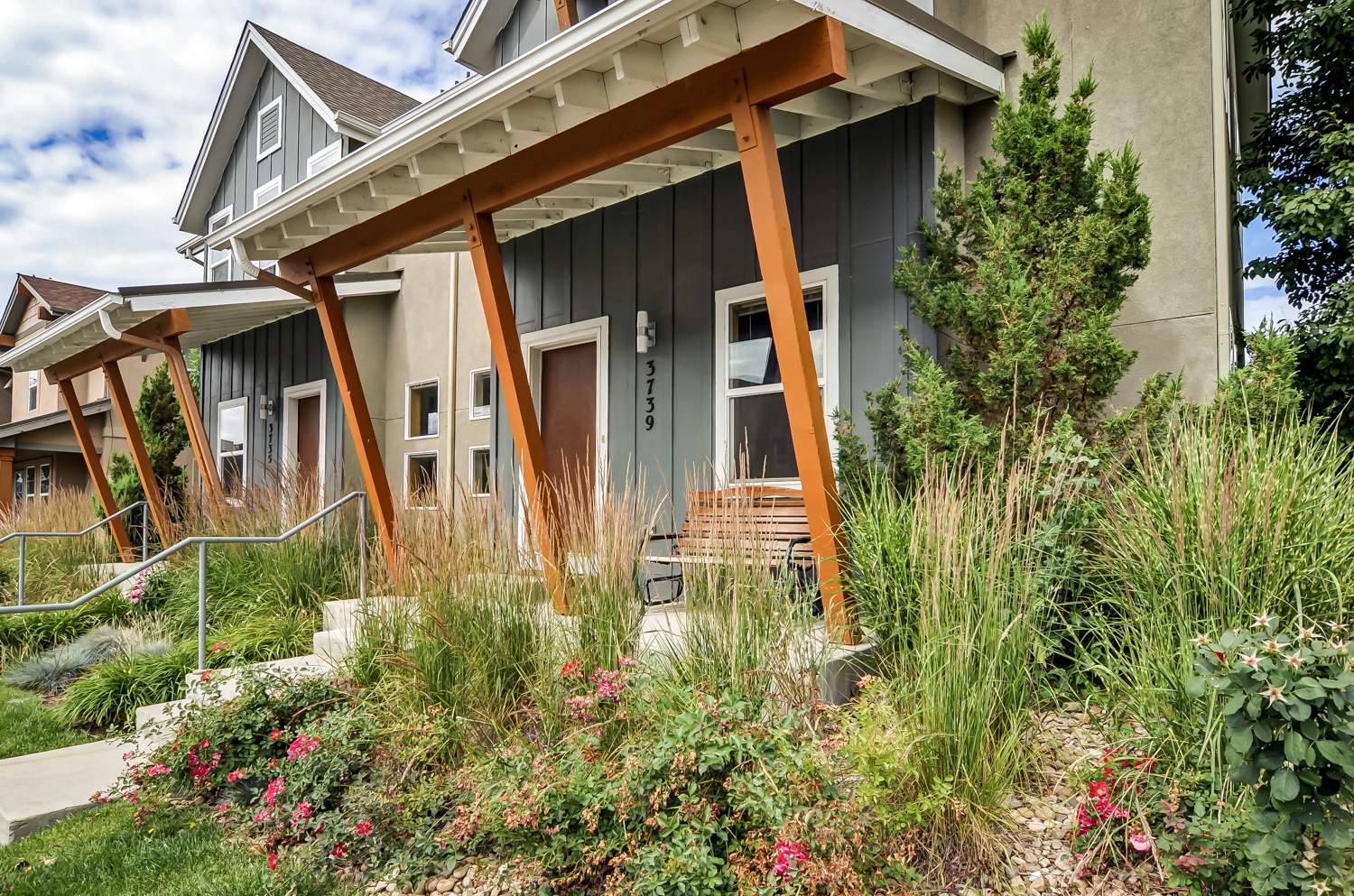
The list is long and includes the following and much more:
Conservation-based connection charges also known as tap fees, impact fees, system development charges, or plant investment fees, these charges can be structured to encourage developers to build water efficiency into new developments, supporting new growth.
Policies and planning tools like master plans, comprehensive plans, and even water efficiency plans. In Colorado, any town or county with more than 25,000 residents must develop a master plan to guide its land use. In the past, few communities incorporated a water resources element into their comprehensive plans, but today some are coming up with innovative applications of land use rules.
More Resources from WEco on Land Use and Water
New Bills on Water Speculation, Land Use, and Instream Flows Advance at Colorado Capitol
 In February 2020, Colorado lawmakers have pushed forward water bills that would study ways to strengthen anti-speculation laws, offer a new avenue to set aside more water for streams, and authorize cities to consider state conservation goals and future water supplies before approving new development. Read the story from WEco’s Fresh Water News.
In February 2020, Colorado lawmakers have pushed forward water bills that would study ways to strengthen anti-speculation laws, offer a new avenue to set aside more water for streams, and authorize cities to consider state conservation goals and future water supplies before approving new development. Read the story from WEco’s Fresh Water News.
Citizen’s Guide to Colorado Water Conservation
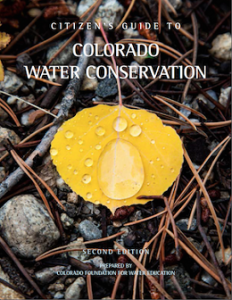 Find it online here and read about examples for water-smart growth, like in Douglas County where officials were among the first to include water use in a city’s comprehensive land use plan, and additional ideas and strategies, starting on page 13.
Find it online here and read about examples for water-smart growth, like in Douglas County where officials were among the first to include water use in a city’s comprehensive land use plan, and additional ideas and strategies, starting on page 13.
Go Time for Colorado’s Water Plan: Meeting the Plan’s Land Use Goals
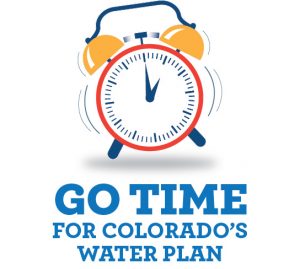 The Colorado Water Plan set “a measurable objective that by 2025, 75 percent of Coloradans will live in communities that have incorporated water-saving actions into land-use planning.” The water plan outlines a five-step action plan and describes several initiatives that are already underway to work toward this goal. Check out this blog post from 2016 that takes a deeper dive into those actions.
The Colorado Water Plan set “a measurable objective that by 2025, 75 percent of Coloradans will live in communities that have incorporated water-saving actions into land-use planning.” The water plan outlines a five-step action plan and describes several initiatives that are already underway to work toward this goal. Check out this blog post from 2016 that takes a deeper dive into those actions.
Headwaters Magazine: The Water/Land Use Nexus
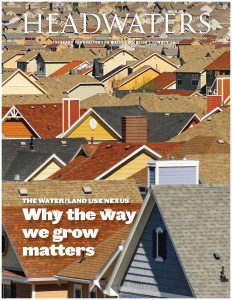 Read this summer 2015 issue of Headwaters to explore the nexus of land use and water, opportunities to merge these fields of planning, and protections to ensure the adequacy of water supplies—for those who call Colorado home today and tomorrow.
Read this summer 2015 issue of Headwaters to explore the nexus of land use and water, opportunities to merge these fields of planning, and protections to ensure the adequacy of water supplies—for those who call Colorado home today and tomorrow.
Pricing the Priceless
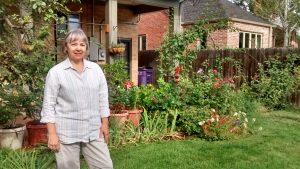 Some Colorado communities are rethinking their tap fees with a view to encouraging more water wise development. Listen to the radio story produced through Connecting the Drops, our partnership with Rocky Mountain Community Radio stations.
Some Colorado communities are rethinking their tap fees with a view to encouraging more water wise development. Listen to the radio story produced through Connecting the Drops, our partnership with Rocky Mountain Community Radio stations.
Resources from Other Organizations
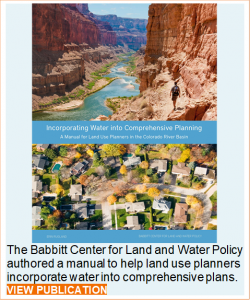 Incorporating Water into Comprehensive Planning: A Manual for Land Use Planners in the Colorado River Basin
Incorporating Water into Comprehensive Planning: A Manual for Land Use Planners in the Colorado River Basin
From the Babbitt Center for Land and Water Policy, this manual details how land use planners in the seven Colorado River Basin states (Arizona, California, Colorado, Nevada, New Mexico, Utah, and Wyoming) can create a comprehensive planning process that promotes water sustainability for all residents of the region in the years ahead. It includes more than 100 additional resources and examples from plans in all seven states.
Integrating Water Efficienct into Land Use Planning in the Interior West: A Guidebook for Local Planners
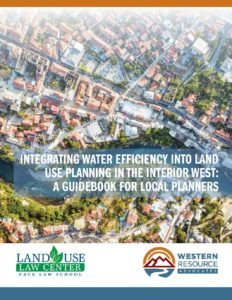 Western Resource Advocates teamed up with Pace University’s Land Use Law Center to develop a comprehensive guidebook that provides land use planners with the resources necessary to fully integrate water efficiency into their land use planning efforts. This Guidebook provides hundreds of techniques, sample codes/policies, and community examples that explain how to reduce the water footprint of new development.
Western Resource Advocates teamed up with Pace University’s Land Use Law Center to develop a comprehensive guidebook that provides land use planners with the resources necessary to fully integrate water efficiency into their land use planning efforts. This Guidebook provides hundreds of techniques, sample codes/policies, and community examples that explain how to reduce the water footprint of new development.
Best Practices for Implementing Water Conservation and Demand Management through Land Use Planning Efforts: Addendum to the 2012 Guidance Document
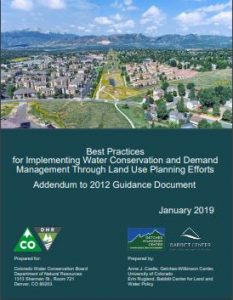 This addendum, adopted by the Colorado Water Conservation Board in January 2019, includes land use best practices that can be implemented by water providers, either independently, or through collaboration with a land use authority. It is tailored to Colorado communities, uses numerous examples and additional resources, and is designed to be adapted as applicable to varying local circumstances.
This addendum, adopted by the Colorado Water Conservation Board in January 2019, includes land use best practices that can be implemented by water providers, either independently, or through collaboration with a land use authority. It is tailored to Colorado communities, uses numerous examples and additional resources, and is designed to be adapted as applicable to varying local circumstances.
Growing Water Smart The Water-Land Use Nexus
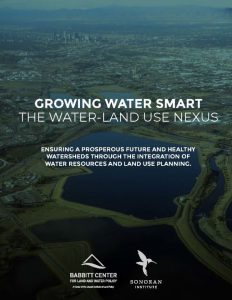 This resource guide from the Sonoran Institute and Babbit Center for Land and Water Policy is intended to help communities identify the most appropriate intervention points related directly to land use that will help you achieve your community’s water resource management goals. Growing Water Smart also offers trainings and assistance to implement practices. Find additional resources here.
This resource guide from the Sonoran Institute and Babbit Center for Land and Water Policy is intended to help communities identify the most appropriate intervention points related directly to land use that will help you achieve your community’s water resource management goals. Growing Water Smart also offers trainings and assistance to implement practices. Find additional resources here.

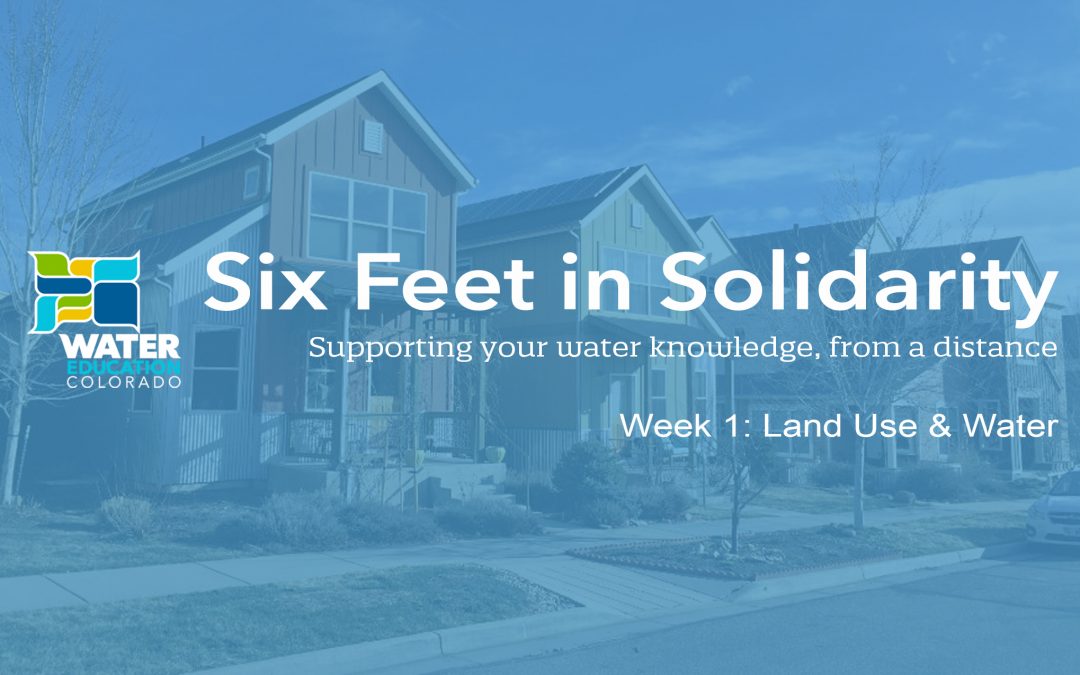
 Print
Print